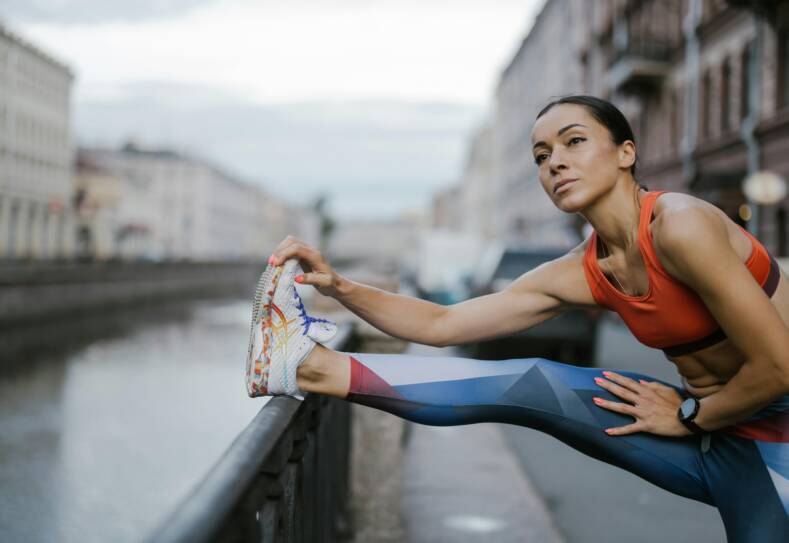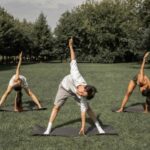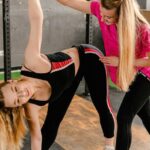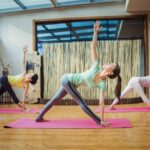Stretching is often a debated topic among fitness enthusiasts and experts. Traditionally, exercises are categorized into dynamic and static stretches. Dynamic stretches involve movement and are typically recommended to prepare the muscles for the intensity of the workout to follow. They serve as a way to warm up the body, increasing blood flow and reducing the risk of injury. Common examples include lunges and shoulder circles, which mimic the activity to be performed.
Conversely, static stretching involves holding a stretch for a period of time without movement and is often advocated for post-workout routines. After exercise, the muscles are warm, making it an optimal time to increase flexibility and aid in recovery. Static stretches are intended to be held for around 30 to 60 seconds, promoting muscle relaxation and helping to alleviate potential soreness post exertion.
Understanding when and how to incorporate stretching into a workout routine can enhance performance and reduce the risk of injury, making it an integral component of both the warm-up and cool-down phases. While dynamic stretches prime the muscles for action, static stretches are best saved for after the workout to capitalize on the muscles’ increased temperature for optimal flexibility gains.
The Importance of Stretching
Stretching plays a crucial role in maintaining muscle health and flexibility, which are vital for both daily living and exercise. By incorporating stretching into one’s routine, people can foster better mobility and reduce the risk of injuries.
Flexibility and Range of Motion
Stretching is instrumental in enhancing an individual’s flexibility and range of motion. Regular stretching exercises help to lengthen muscles and increase the joints’ capability to move through their full range of motion, thereby contributing to more fluid and efficient body movements.
- Flexibility: Improved flexibility reduces the difficulty with simple tasks such as bending and reaching.
- Range of Motion: Enhanced range of motion allows muscles and joints to move more freely, which can lead to improved performance in physical activities.
Injury Prevention and Muscle Health
Proper stretching, particularly when muscles are warmed up, can aid in injury prevention and promote muscle health. Stretching can provide several health benefits: it promotes circulation, minimizes muscle soreness, and prepares the muscles for the stress of exercise, which can help prevent injuries.
- Circulation: Stretching increases blood supply to the muscles and joints, which can help enhance nutrient distribution and remove waste byproducts in muscle tissue.
- Muscle Soreness: Stretching after exercise can lead to a reduction in muscle soreness and aid in recovery.
- Injury Prevention: Keeping muscles flexible and preventing tightness can decrease the likelihood of strains and sprains.
In summary, incorporating stretching into one’s routine is essential for maintaining muscle flexibility, optimizing range of motion, preventing injuries, and improving overall muscle health.
Types of Stretching
Stretching is an integral part of any fitness regimen, focusing on flexibility and injury prevention. Two primary types of stretching are employed by individuals aiming to enhance their workout performance and recovery: dynamic stretching and static stretching.
Dynamic Stretching Explained
Dynamic stretching involves movement-based stretches that prepare the body for activity. It consists of controlled, gentle movements that typically simulate the exercise to be performed. Unlike static stretches, dynamic stretches are not held in a final position, making them ideal for warming up as they raise body temperature and increase blood flow. Examples of dynamic stretches include leg swings, arm circles, and lunges that incorporate a bounce to propel the movement.
Key benefits:
- Enhances flexibility specific to the movements of the activity
- Prepares the body for the physical demands of the exercise
The Role of Static Stretching
Static stretching, on the other hand, involves holding a stretch in a single, steady position for a certain length of time, usually between 20 to 60 seconds. It is most beneficial after exercising, as it helps in muscle recovery and maintaining flexibility. Static stretches should be performed slowly and without any bounce, as it can cause muscle strain. They are aimed at elongating the muscle to a point of mild discomfort and then holding that position.
Key attributes:
- Performed slowly to elongate muscles
- Aids in recovery post-exercise
By incorporating both dynamic and static stretching into an exercise routine, individuals can enjoy a balanced approach to flexibility and muscle preparedness.
Stretching Before a Workout
Before engaging in the main exercise, it’s crucial for one to prepare the body, especially the muscles, for the upcoming activity. Proper warm-up, including dynamic stretches, not only can help increase blood flow to the muscles but also can potentially enhance performance and reduce the risk of injury.
Preparing the Muscles for Exercise
A proper warm-up serves to gently prepare the body for the demands of a workout session. It typically involves light activity such as walking or jogging, which starts a gradual increase in blood flow and raises the temperature of the muscles. Warmed-up muscles are more pliable, which may help to improve the effectiveness of the workout and reduce the chance of strains.
Dynamic Stretches to Start With
Dynamic stretches are active movements where joints and muscles go through a full range of motion. They are used to prepare the body for movement and can serve as a bridge between the initial warm-up and the main exercise.
Here is a list of dynamic stretches one may incorporate into a warm-up routine:
- Arm Circles: Extend the arms parallel to the ground and rotate them in small circles, increasing to larger circles.
- Leg Swings: Hold onto a stable surface and swing one leg forward and back then side to side.
- Walking Lunges: Step forward into a lunge position, lowering the hips until both knees are bent at a 90-degree angle.
Dynamic stretching should be performed in a controlled manner, generally for 5-10 minutes before progressing to more intense exercise.
Stretching After a Workout
Incorporating stretching after a workout is crucial in promoting muscle recovery and reducing soreness. This practice helps to ease tension and can enhance relaxation and improved circulation, particularly following strength training.
Aiding Muscle Recovery
After strenuous activity, muscles tend to be tight and fatigued. Stretching can mitigate muscle soreness and expedite the recovery process. By gently elongating the muscles, one promotes relaxation and a decrease in pain, leading to a more comfortable post-exercise period. Enhanced blood flow through stretching can further clear metabolic waste, contributing to quicker muscle recuperation.
Static Stretches for Cooling Down
Upon completing a workout, static stretches are recommended to effectively cool down the body. These stretches involve:
- Extending a muscle group to a point of mild tension
- Holding the stretch for roughly 30 to 60 seconds
This systematic approach allows the muscles to relax slowly, supporting the transition from an active state to a state of rest post-exercise. It’s advised to perform static stretches after every workout session for maximum benefits in flexibility and tension relief.
- Example Stretch: Hamstring Stretch
- Position: Sitting or standing
- Duration: Hold for 30-60 seconds
- Frequency: Practice after each workout
Targeted Stretching Routines
Effective stretching routines can help improve flexibility, reduce the risk of injury, and provide relief from muscle tension. These routines are designed to focus on specific areas, ensuring that stretches are performed properly for each muscle group.
Upper Body Focus
An upper body routine emphasizes the shoulders, neck, and biceps. It is crucial to maintain a straight back to avoid potential injuries and to maximize the stretch’s effectiveness.
- Shoulders:
- Stand or sit with your back straight, pull one arm across your chest, hold it with your other arm, and press gently toward your chest to stretch your shoulders.
- For a deeper stretch, interlace your fingers behind your back, straighten your arms and lift your hands upwards.
- Neck:
- Gently tilt your head to one side, bringing your ear toward the shoulder until a stretch is felt on the opposite side of your neck.
- For a side neck release, place one hand on top of your head and slightly apply pressure, increasing the stretch.
- Biceps:
- With your arm extended against a wall, fingers pointing away from your body, rotate your body slightly away to feel a stretch along your biceps and chest.
Lower Body and Back Care
Stretching the lower body can alleviate back pain and increase motion in the hips, hamstrings, and calves.
- Hamstrings:
- Perform a hamstring stretch by sitting on the ground with legs extended, hinge forward at the hips, and reach for your toes while keeping your back straight.
- Calves:
- A calf stretch can be achieved by standing arms-length from a wall, placing one foot behind the other, and gently leaning forward while keeping the back heel on the ground.
- Lower Back and Hips:
- Lie on your back with knees bent and both feet on the floor; gently arch your lower back and then press it into the floor to stretch your lower back.
- For hip flexors, kneel on one knee, place the other foot flat on the floor in front of you, and lean forward, squeezing your glutes for a deeper stretch.
- Piriformis Stretch:
- While seated, cross one leg over the other; place your opposite elbow on the crossed knee, and apply gentle pressure while rotating your torso to stretch the piriformis muscle.
Stretching Techniques and Safety
Maintaining proper technique and safety during stretching is crucial to prevent overstretching and injury. Attention to alignment, posture, and the natural limits of the joints ensures a safer and more beneficial stretching regimen.
Avoiding Overstretching
Overstretching occurs when a person extends muscles beyond their normal range of motion, potentially leading to injury. To avoid this:
- Always warm up muscles before stretching to improve elasticity.
- Gradually ease into stretches, avoiding any sudden movements.
- If a stretch causes pain, stop immediately and reassess your technique.
- Listen to your body’s cues and understand the difference between a beneficial stretch and overextension.
Proper Alignment and Posture
Maintaining correct alignment and posture during stretching maximizes its benefits and minimizes the risk of injury. Here are some specific pointers:
- Neck: Keep your neck in a neutral position, aligning it with your spine.
- Shoulders: Should be kept down and back, avoiding rounding forward.
- Back Straight: Engage your core muscles to help keep your back straight.
- Breathing: Breathe deeply and consistently to promote relaxation and proper muscle function.
- Rotation: When rotating joints, do so gently, ensuring the movement reflects your natural range of motion.
Seek guidance from a physical therapist or personal trainer if unsure about the correct alignment and posture for your body type or if you have pre-existing conditions that may affect your ability to stretch safely. They can provide personalized coaching on how to adjust your technique to reduce the chances of overstretching and injury.
Advanced Stretching Methods
Advanced stretching methods incorporate techniques that are typically utilized by athletes and individuals who have a good base level of flexibility. These methods aim to enhance muscular function and flexibility beyond standard routines.
Proprioceptive Neuromuscular Facilitation (PNF)
Proprioceptive Neuromuscular Facilitation (PNF) is a strategy that combines passive stretching and isometric contractions to enhance flexibility. PNF typically involves three stages:
- The stretching muscle is brought to a point of tension.
- The individual then contracts the muscle without moving (isometric), typically against a resistance for 6-10 seconds.
- The muscle is relaxed, and a controlled stretch is applied for about 30 seconds to stretch the muscle further.
Using Tools for Enhanced Stretching
Incorporating tools such as towels, foam rollers, and other supports can aid in performing advanced stretches effectively. Specific tools facilitate deeper stretches or provide stability for more controlled stretching experiences.
- Towels: Can be used to extend the reach or to provide tension during a stretch, beneficial for instance in hamstring stretches.
- Foam Rolling: Also known as self-myofascial release, foam rolling can help reduce muscle tightness, soreness, and inflammation, and increase your joint’s range of motion. It is particularly useful for targeting specific muscle groups before attempting deeper stretches.








